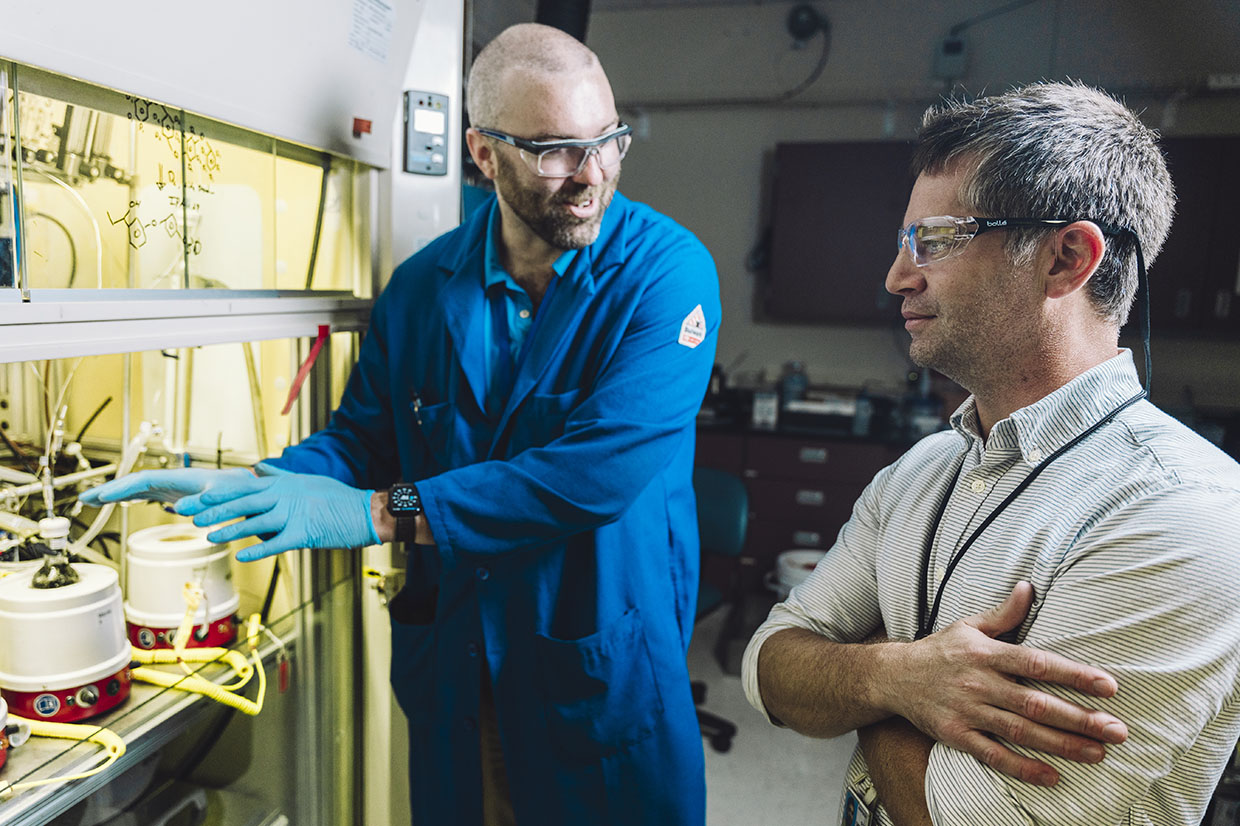“We found that the interaction with hydrogen, metals and magnetic fields is actually a very useful way to create a hydrogen sensor.” – George Larsen

George Larsen (right) leads the Hydrogen Isotope Science team at SRNL. SRNL photo by LJ Gay, SRNS.
Savannah River National Laboratory (SRNL) strives to continually improve process efficiencies, generate innovation and increase impact. The Laboratory Directed Research and Development (LDRD) program helps meet these objectives by providing early investment in research concepts, discovery science and programs that further strategic goals and future missions.
Each year, the LDRD program recognizes a Most Valuable Project (MVP) that generated the highest return on investment during the previous five-year period. For 2023, the MVP award went to George Larsen and his Hydrogen Isotope Science team for their work on hydrogen process imaging using magnetic fields.
“I was trying to think of a way that we could use an external system to probe the interior of a process vessel to provide information of what type of hydrogen content might be in there,” says Larsen.
Hydrogen, the smallest element, can get absorbed into solid materials. The project presented new concepts for magnetic measurement of metal hydrides and successfully demonstrated that this technology can detect hydrogen in metals enclosed inside a metal vessel.
“We demonstrated that we could measure the hydrogen content of the metals through solid vessels and that we could create an image of that,” says Larsen. “We found that the interaction with hydrogen, metals and magnetic fields is actually a very useful way to create a hydrogen sensor.”
Much of the Hydrogen Isotope Science group’s work is focused on tritium, an isotope of hydrogen, and supporting the Savannah River Site’s (SRS) Tritium Enterprise.
These measurements of hydrogen content are important. Tritium is a radioactive material and component of nuclear weapons. The Department of Energy (DOE) has strict rules on radiological accountancy, such as keeping track of all the tritium in a facility like those at SRS, or when it’s transferred to another site. While the current measurement process used is very accurate, it is slow – requiring more time, effort and expense than is desired.
The novel idea of using magnetic fields and sound execution of supporting research resulted in the development of advanced, ultrafast hydrogen sensors with a record response time of 90 milliseconds. The idea was to deploy these sensors in the field.
The MVP award is based on objective measures of the return on investment of the research, including follow-on-funding, publications, presentations, intellectual property, new hires, partnerships and awards. Larsen and his team, in collaboration with the University of Georgia (UGA) and four other academic institutions, helped develop SRNL’s expertise in magnetic characterization.

A top-view scanning electron microscope image of palladium-cobalt nano-patchy, the material that comprises the hydrogen sensor Larsen’s team developed. Photo by Savannah River National Laboratory.
The research’s contributions to the scientific community as well as its relevance to tritium, clean energy and legacy waste missions, will continue to help maintain SRNL’s strength in science and technology. It has accumulated an impressive return on investment, including: an additional $2 million in follow-on projects from three separate funding opportunities; seven publications in top peer-reviewed journals, including Nano Energy, Nature Communications and Applied Nano Materials; and one patent for the team’s sensor concept.
“We spent a lot of time getting measurements right, performing additional experiments, and diving deep into the fundamental mechanisms of our materials,” says Larsen. “This was ‘below-the-surface’ work that allowed us to take these sensors to the next level and inspired follow-on projects.”
Larsen credits his close collaboration with Professor Tho Nguyen and his UGA students, Hoang Luong and Minh Pham, as a primary reason for the project’s success. He’s also proud to contribute meaningful research to SRNL.
“[George] is a remarkable figure in SRNL and I am confident he will continue harvesting more successes from his efforts,” says Jose Cortes-Concepcion, manager of the SRNL Hydrogen Isotope Science Group. “The group is very happy to have him as a teammate and mentor.”
SRNL’s LDRD program fosters early exploration and application of creative and potentially transformational ideas that contribute to the global scientific community and enhance the lab’s ability to execute current and future mission priorities.
Larsen’s scientific leadership and risk-taking innovation are an excellent representation of LDRD and SRNL’s overall mission.
For more information about SRNL Laboratory Directed Research and Development (LDRD), visit https://www.srnl.gov/research-areas/emerging-science-technology/laboratory-directed-research-development/